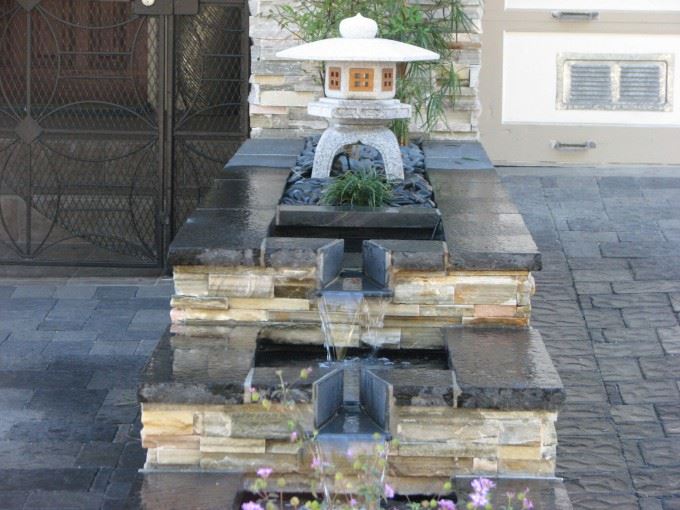
At Tamate Landscaping, we do our best to use Japanese accents in your garden in order to enhance the overall visual appearance, transform the atmosphere, and create a spiritual sanctuary in your home. These accents act as a kind of natural therapy and promote relaxation, which improves mental health considerably.
Overall, using these Japanese garden accents can lead to improvements in both mental and spiritual health, as well as providing a visually stunning outdoor space to enjoy.
Using these tips to incorporate Japanese accents into your garden can lead to a variety of improvements in life. The beauty of the garden itself can foster a sense of tranquility, improving your overall mood, which can reduce stress and anxiety. This calmness can positively affect mental health and make it easier to deal with the daily stresses of life.
Furthermore, these gardens can offer a quiet place for contemplation and meditation, benefiting your spiritual health by providing peace and clarity.
Accents are also known as focal points. Accents describe the artistry of placing unique rocks, colorful lanterns, and Bonsai tree decorating to create a sense of harmony and peace. We’ll help you to understand the unique world of Japanese garden focal points. We’ll also speak on the cultural and historical garden elements that have made lanterns, ornaments, and statues so unique.
Lanterns in Japanese Gardens
Japanese lanterns take root in Buddhist traditions. In ancient times, Japanese culture used lanterns to light paths that led to shrines and temples. Over time, the lanterns became a symbol of spiritual enlightenment. You can carry forward the rich history of Japanese lanterns by choosing stone (Ishidoro), bronze (Bronze Toro), or hanging lanterns (Tsuridoro) for your garden.
Japanese lanterns, often made of stone and artistically crafted, serve as excellent night accents, illuminating the garden with a calming glow. When someone uses this tip, they will create an inviting and tranquil evening environment in their garden. For instance, imagine a stressful day at work, with a garden lit by these enchanting lanterns awaiting you at home. This space can serve as a place for relaxation and meditation, thus reducing stress levels and increasing overall well-being.
Stone lanterns exude charm and symbolize strength and durability. Bronze lanterns exhibit amazing craftsmanship, and hanging lanterns will bring a sense of peace as they gently illuminate your landscape. Consider placing your lanterns near harmonizing pathways and gracefully cascading water features for soothing effects.
Lanterns can enhance the elegance of your garden in several ways. They’re functional while adding a sense of rhythm to the landscape. Soft and warm lighting tends to create a magical effect. Lantern colors can also match seasonal themes.
You can also choose an entire assortment of different designs and styles. Choose a design that matches your own personality and blends with your overall garden theme, and pick from modern, themed, or traditional lanterns.
Ornaments in Japanese Gardens
Millions of people have a wonderful connection to Japanese culture. If you’re among them, placing Japanese ornaments in your garden is the perfect way to express your fondness. You’ll find water basins known as Tsukubai in nearly every Japanese garden. Water basins symbolize values of simplicity, natural elements, balance, and harmony.
Bamboo fences (Take-gaki) add lots of rustic charm and are a practical choice that harmonizes with the garden’s natural surroundings. Imagine standing quietly on your bridge (Taiko-bashi) and looking out over your garden, where the pond’s gentle ripples captivate you in a moment that seems to freeze time.
Ornaments like unique rocks and bonsai trees add depth and character to a garden. By using these accents selectively and strategically, one can improve their garden aesthetic and create a visual narration. For example, a rock strategically placed near a water feature can replicate the appearance of naturally occurring scenery, stimulating mental and visual interest. It also contributes to mindfulness, as its design encourages contemplation and appreciation of subtle details.
Every Japanese garden theme encourages a person to pay attention to the mindfulness of the moment. A renewed connection to nature can benefit anyone, and this connection is what water basins, bamboo fences, and bridges will inspire in you. You’ll discover that Japanese gardens combine elements such as stone lanterns, bridges, and bamboo fences in ways that blend harmony with nature in some of the most pleasing ways. The exquisitely designed garden gates and bridges showcase impressive craftsmanship through the intricate hand carving on display.
Statues in Japanese Gardens
Every statue has Shinto and Buddhist influences that communicate myths and stories. With a little research, you can learn the stories associated with each statue. Such stories can add a layer of cultural richness to your garden that will inspire contemplation and reflection on the world around you.
Statues, often of religious or cultural significance in Japanese gardens, can create a spiritual sanctuary. Including these in a garden can improve a person’s spiritual health by providing them with a serene space for reflection. For instance, a statue of Buddha in a corner surrounded by foliage could serve as a spiritual focal point, encouraging moments of solitude, prayer, or meditation. These actions can result in a heightened sense of self-awareness, inner peace, and emotional balance.
Several types of statues include the Jizo Bodhisattva, which are protectors of children and travelers. Kitsune statues represent intelligence and magic. The Tengu statues, with wings and long noses, provide protection. Each statue type gives dynamic energy to its garden and brings balance and harmony to the environment when strategically placed.
There’s definitely an expression of art in every Japanese garden theme. Whether you choose to place statues near water or nestle them among beautiful plants, statues will bring a natural sense of harmony and balance to your garden. Japanese statues have the power to inspire visitors to contemplate nature and life.
Maintenance and Care
Maintaining the beauty of your Japanese garden requires care on a regular basis. From stone lanterns and bamboo fences, you’ll want each element to retain its original charm. When planning your garden, make sure to remain mindful of changing weather conditions and the most durable materials.
Also, consider that you may have to make seasonal placement adjustments and apply preservation techniques. Apply layers of organic mulch where needed, and choose plants suited to your local climate. Prune your plants to prevent diseases. Windbreaks like shrubs or bamboo screens can help protect your garden from strong seasonal winds.
Modern Interpretations and Adaptations
People of every culture appreciate the beauty of Japanese gardens. Many of these people are actually garden enthusiasts. As such, many Japanese gardens spring up in non-traditional settings. You can find them on rooftops, in urban settings, and even indoors in some homes. You’ll find the same lanterns, ornaments, and statues that you’d find in a traditional Japanese setting.
Never hesitate to seek the professional help of landscape contractors who can ensure that your garden stonework design is innovative, creative, and beautiful. They can fuse old and new concepts that will pay respect to time-honored traditions of Japanese garden design.
Conclusion
Japanese garden designs will always employ lanterns, ornaments, rocks, and statues as symbolic elements of Japanese culture. Japanese culture has always placed a strong emphasis on achieving spatial harmony and balance, and you’ll discover this in each unique garden design. Placing a unique Japanese garden in your home’s space isn’t just about creative landscaping. It’s a profound welcoming of deeper cultural values.
Finding the right balance when arranging the different elements. Japanese gardens are all about harmony and careful composition, with each element placed in just the right spot for the maximum aesthetic and symbolic impact. Therefore, achieving this balance requires a keen eye, a robust understanding of Japanese aesthetic principles, and, sometimes, a bit of trial and error. But the end result – a beautiful Japanese garden that brings serenity and beauty – makes all the hard work worthwhile.



